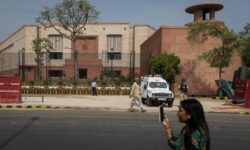NEW DELHI:
A thoroughly illustrated compendium of all aspects of India’s most vital farming belt is out in public domain, as a bilingual ‘Agricultural Atlas of Madhya Pradesh’ has been brought out with exciting glimpses at the latest maps and information on the state’s geography, rivers, soils, climate, demography, livestock, changing cropping patterns a nd production of different crops.
nd production of different crops.
A joint endeavor by the Centre for Policy Studies and the Madhya Pradesh Council for Science and Technology (MPCST), the glossy 300-page bilingual work—in Hindi and English—was released in the national capital by Rashtriya Swayamsevak Sangh general secretary Bhaiyyaji Joshi in the presence of former union minister Murli Manohar Joshi, MP and host of top officials allied with the landmark project. Overall, it drills deep into the factors that have made Madhya Pradesh the country’s fastest-growing state in agriculture.
The function at Indira Gandhi National Centre for the Arts (IGNCA) also saw the release of two resource atlases of a couple of Madhya Pradesh districts: Datia and Tikamgarh.
Edited by Dr. J. K. Bajaj, Director of Centre for Policy Studies which carries out research and study aimed at comprehending and cherishing the essential civilisational genius of India, the hard-bound atlas brimming with photos records the extraordinary growth in all aspects o agriculture Madhya Pradesh witnessed in the last about one and a half decades. Dr Bajaj gave a detailed explanation of them at the function which was also addressed by Bharatiya Kisan Sangh Organising Secretary Dinesh Dattatreya Kulkarni, IGNCA Chairman Ram Bahadur Rai, MPCST Director-General Pramod K Varma and Agriculture Expert M.D Srinivas.
Bhaiyyaji Joshi, speaking on the occasion, said it is time the country studied from the post-Independence “mistakes” it committed in farming practice, and corrected the course in a way that protected the earth as well as the people by coming out of a “monotonous mindset” about the field.
“Even farmers themselves consider as jobless people. It must change,” he added.
Dr. Murli Manohar Joshi, who holds a PhD in physics and was the human resources development minister in an erstwhile NDA government, stressed on the links between agriculture, economy and society at large. “How a change in farming pattern altered its people will always be an interesting subject. This atlas is a major stride in the country’s social science,” he said.
The book comprises MAPS geography, which delves deep into the state’s topography, rivers, water-bodies, soils and climate. It also throws fresh light on Madhya Pradesh’s demography, including the rural-urban distribution and the distribution of the Scheduled Castes and Scheduled Tribes across the districts from 1901 onwards.
As for the state’s land use, it speaks about the net cultivated area, gross cultivated area, double-cropped area and area under forests across the districts for 1976-81 and 2005-10. The topic of irrigation essays net-irrigated area, gross-irrigated area and area under different sources across the districts for 1976-81 and 2005-10, while livestock description covers the total, per-person, and its different components across the districts for 1982 and 2007 along with graphs of growth from 1966 to 2007.
The book also comes out with district-wide details (for 1976-81 and 2004-09)such as the state’s area under cereals, pulses and oilseeds across the districts, area under different cereal crops, under different pulses crops; under different oilseeds crops , under other crops like cotton, sugarcane, vegetables, and fodder, per-capita production of different crops and long-term trends of growth.
In addition, the atlas gives several graphs documenting the growth of different parameters of agriculture from 1964 to 2012 for the state as a whole and for the individual districts. It has statistical tables that give tabulation of all the state- and district-level data that has been used in the maps and the graphs. Plus, there are photographs on different aspects of the geography and agriculture across Madhya Pradesh.




